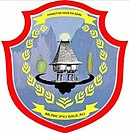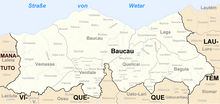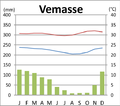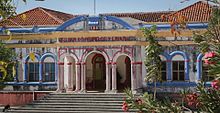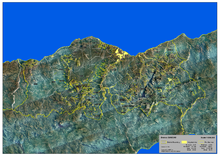Baucau (Municipality)
|
Munisípiu Baukau (tetum) Município de Baucau (port.) |
||

|
||
| Data | ||
| Capital | Baucau | |
| surface | 1,504.17 km² (4.) | |
| Population (2015) | 123.203 (3.) | |
| Population density | 81.91 inh / km² (5.) | |
| Number of households (2015) | 22,976 (2.) | |
| ISO 3166-2: | TL-BA | |
| Administrative offices | Residents | surface |
| Baguia | 12,962 | 212.18 km² |
| Baucau | 47.294 | 3699.62 km² |
| Laga | 18,359 | 194.07 km² |
| Quelicai | 17,450 | 214.15 km² |
| Vemasse | 9,643 | 358.47 km² |
| Venilale | 17,495 | 155.70 km² |
| map | ||

|
||
Baucau ( tetum Baukau ) is a municipality of East Timor on the north coast of the country. The capital is the city of the same name, Baucau .
In 1936, Baucau was renamed São Domingos by the Portuguese . But the name did not catch on and a few years after the Second World War , the old name was reverted to.
geography
The municipality of Baucau is located in the northeast of the country on the Strait of Wetar , opposite the island of Wetar . In the west it borders on the municipality of Manatuto , in the south on the municipality Viqueque and in the east on the municipality Lautém . Baucau is divided into the administrative offices of Baguia , Baucau , Laga , Quelicai , Vemasse and Venilale (formerly Vila Viçosa).
Most of the municipality is located at an altitude of between 100 and 500 m . Only directly on the coast does the land quickly fall to sea level. Between the larger rivers, the country rises over 500 m to the massifs of Monte Mundo Perdido (municipality of Viqueque) in the mid-west and Matebian in the south-east, which is the third highest mountain in East Timor at 2316 m . To the west of the municipality, the Laleia and Manuleiden rivers flow into the Wetar Strait. To the east of Baucau there are the rivers Seiçal , Borauai , Lequinamo , Binagua and other small rivers. Only the Seiçal has water all year round, as it is fed from Viqueque in the south. Baucau also has a wide coastline with sandy beaches suitable for swimming and other water sports. There are several limestone caves in the Baucau administrative office. The Baninau - sinkhole has a diameter of nearly a kilometer.
Baucau has had an area of 1,504.17 km² since the 2015 regional reform (previously 1,507.95 km²). There were minor border shifts to Viqueque and Lautém. Already in 2003 the border to Viqueque was changed significantly.
- Climate diagrams
The Seiçal River
Residents
123,203 (2015, 2011: 117,348 inhabitants) live in the municipality of Baucau. The population density is 81.91 inhabitants per square kilometer. The average age is 18.5 years.
In 2004 a woman had an average of 6.62 children in the Baucau administrative office, in Venilale 7.38, in Vemasse 7.61, in Quelicai 7.73, in Laga 8.05 and in Baguia 8.70 (national average 6.99). Between 1990 and 2004 the number of inhabitants grew by 1.07% annually. However, many residents emigrate to other parts of the country, especially to the state capital Dili . Over 12,000 of the residents of Dilis in 2004 were born in Baucau. As a result, the number of residents has even decreased at times in recent years. The child mortality rate in 2002 in the Baucau administrative office was 89 deaths per 1000 live births (1996: 111), in Quelicai 108 (141), in Venilale 114 (135), in Baguia 122 (167), in Laga 136 (155) and in Vemasse at 147 (139). The national average was 98. Vemasse is one of 14 administrative offices in which, contrary to the national trend, it rose. Together with Laga, Vemasse is one of the eight administrative offices with the highest child mortality rates in the country.
In the east and center of Baucau, Makasae is the most widely spoken language. 60.3% of the population of Baucau named it as their mother tongue in the 2015 census. In the west of Baucau, most of the residents speak Waimaha (16.7%). In the administrative office of Venilale, the majority of the population speaks Midiki (7.0%). 13.2% in the community speak Tetum as their mother tongue. In addition, smaller groups speak Naueti (1.2%), Galoli (0.5%) and Kairui (0.4%). If the second languages are also taken into account, in 2015 85.7% spoke Tetum, 43.7% Bahasa Indonesia, 40.9% Portuguese and 20.6% English .
In 2004, 98.3% of the population were Catholics , 0.6% Protestants , 0.3% followers of the traditional, animistic religion of Timor and 0.2% Muslims . In 2015, 98.3% Catholics, 1.4% Protestants, 0.2% Muslims and only 36 animists were registered in the census. There is a mosque in the city of Baucau and there are also some Protestant churches in the community. Most of the few Chinese families have their own house altar.
Most of the schools in the parish are run by the Catholic Church. In 2015, 39.7% of residents aged three or over attended school. 27.7% had left school. 31.4% have never attended school, which is 2.5% above the national average. 6.2% of Baucau's residents only attended pre-school, just under a third only attended primary school. Secondary schools have completed a quarter of the population. Only 4.9% have a diploma or a degree; here, too, the numbers are worse than the national average. The illiteracy rate was 14.2% in 2015 (women: 14.1%; men: 14.3%). In 2004 it was still 52.9%.
| Education | Graduation | ||||||||||
| at school | Finished school | never in a school | Preschool | primary school | Pre- secondary |
Secondary | Diploma / University of Applied Sciences |
university | No graduation | ||
| Women | 38.4% | 26.3% | 34.2% | 5.9% | 27.1% | 12.3% | 14.0% | 0.8% | 3.4% | 0.7% | |
| Men | 41.1% | 29.2% | 28.7% | 6.5% | 31.9% | 11.6% | 13.6% | 1.0% | 4.6% | 0.5% | |
| total | 39.7% | 27.7% | 31.4% | 6.2% | 29.5% | 12.0% | 13.8% | 0.9% | 4.0% | 0.6% | |
history
Thousands of years old rock paintings were found in Uai Bobo (administrative office Venilale), Lie Siri , Lie Kere , Lie Kere 2 and Lie Baai (on the high plateau of the administrative office Baucau) and in the region of Baguia . Near the city of Baucau, a spout hatchet of the Dong Son culture (around 800 BC to 200 AD) was found in what is now Vietnam .
Much of the municipality of Baucau was formerly part of the Kingdom of Vemasse or was under its influence. According to oral tradition, the members of the ruling family Topasse were from Larantuka on the eastern tip of the island of Flores . They had come to East Timor via Oecussi in the 18th century, in the expectation that the Portuguese would found their new colonial capital here on Timor after they had been driven from Lifau in 1769 . In the same year, however, Dili was founded as the new seat of the governor. After all, an administrative headquarters for the region developed in Baucau. A century later, the leader of the Topasse family, the Galoli- speaking Dom Domingos da Costa Freitas (also "Gali Kai") was made Dato-hei (Timorese prince) of Vemasse by the Portuguese .

In 1859 Dom Domingos de Freitas Soares led a minor revolt against the Portuguese, but it was quickly suppressed. Dom Domingos was exiled to Lisbon that same year . As early as the spring of 1861, Vemasse supported the colonial power with fighters against the uprising in Laclo . In June 1863 an uprising of the Makasae of Laga was suppressed by the Portuguese and the village burned down.
The alliance of Vemasses with the Portuguese finally ended with the rebellion of 1867 . In August the people of Vemasse rose and besieged Lalcia . Governor Texeira da Silva ended the siege and put down the uprising with the help of allied Liurais (Timorese petty kings). The Liurai of Vemasse was replaced by his deputy, the Dato-hei , who swore an oath of alliance and promised peaceful relations with the neighbors. In 1869 Gali Kai's son, Dom Francisco da Costa Freitas, was appointed Liurai of Baucau, while his son-in-law, Tomas de Costa Soares, became Dato-hei of Letemumo .
Also Buibau and Venilale were traditional kingdoms Timor, which were ruled by a Liurai. They appear on a list by Afonso de Castro, a former governor of Portuguese Timor who listed 47 empires in 1868.
In 1882 there was fighting between Vemasse and Laleia , for which the commander of the military headquarters was held responsible. In April 1896 the Liurai von Buibau signed a written contract with Portugal on his vassal status.
Close relations existed with the island of Kisar, which is dominated by the Netherlands . They visited each other regularly, traded in gold and water buffalo and the Raja of Vonreli on Kisar paid a tribute to the Liurai of Vemasse. It was not until the end of the 19th century that the Portuguese governor of Timor, José Celestino da Silva (1894–1908) , stopped all contact because the Raja refused to convert from Protestantism to Catholicism. But already 15 years later the contacts were renewed when the Raja von Kisar docked with a fleet of 20 small ships on the beach of Baucau .
In 1903 and 1912 Quelicai's uprisings against the Portuguese colonial rulers failed. In 1912 an uprising against the Portuguese colonial rulers broke out in Baucau, but it was quickly suppressed. 2000 people are said to have died.
In the municipality of Venilale, the Japanese tunnels on the road to Baucau, the so-called seven caves ( Gua Tuju ), are a reminder of the occupation during the Second World War . The administrator of Baucau, then known as São Domingos County , Lieutenant Manuel Jesus Pires , fled to Australia and returned with Allied combat troops to fight the Japanese in the Battle of Timor .
After East Timor declared independence in 1975 , Indonesia began to occupy the country . On December 9, 1975, the Indonesians occupied Baucau and from there advanced further south and towards Laga and Quelicai. By October 1976 the coast of Baucau, the places Baucau and Quelicai and the road from Baucau to Viqueque were occupied. Bases de apoio were created in Baguia and on Matebian, where the refugee civilian population was settled by the FALINTIL resistance movement . From September 1978 the Indonesian army began destroying the bases and occupying the last resistance areas in Viqueque and Baucau. With the base at Matebian, the last one fell on November 22nd. People were dispersed or captured. Until March 1979, the then districts were completely under Indonesian control.
In the 1980s, Quelicai was bombed and combed several times by the Indonesian army while fighting the FALINTIL, resulting in deaths among the residents. On May 29, 1997, elections were held in which representatives of East Timor should be elected to the Indonesian parliament. Several attacks on the Indonesian occupying power and its supporters took place in the surrounding area. On May 28, the former head of the district parliament, Miguel Baptismo da Silva (1987-1992), and his wife were murdered in Baucau. In Seiçal, the vote took place one day late on May 30 because the polling station had been attacked by unknown persons. Abinau Salay, an election worker and member of a Wanra , was injured with a machete. As a result, ten people were arrested. On May 31, an Indonesian security convoy was ambushed in Quelicai. 18 Indonesian police officers and soldiers were killed. In the military action that followed, 114 residents were arrested.
In November 2005, two Timorese police officers were killed by a bomb dropped on their vehicle in Vemasse.
After the parliamentary elections in 2007 , violent riots broke out in Baucau, Quelicai and Venilale, among others, during the election campaign and after the results were announced. Over 1,500 people fled their homes in what was then the Baucau district alone. An attack on an orphanage in Baguia and the rape of several girls there caused a particular stir.
In 2014, the districts across East Timor were transformed into "parishes" and the sub-districts into "administrative offices".
politics
| Administrador Konsellu |
|
| Armando Eduardo Pinto Correia | 1928-1934 |
| Manuel Jesus Pires | until 1942 |
| Clementino dos Reis Amaral | until 1975 |
|
District President (Bupati) |
|
| Abel da Costa Belo (APODETI) | 1976-1982 |
| Colonel I. Gusti Ngurah O. (Military) | 1982-1987 |
| Herman Sediono (military) | 1988-1992 |
| Virgílio Maria Dias Marçal (UDT) | 1992-1999 |
|
Administrador |
|
| Mário Nicolau dos Reis | 2000-2002 |
| Micaela Ximenes | 2002-2004 |
| Luís Aparicio Guterres | 2004-2008 |
| António Augusto Guterres (interim) | 2008 |
| Domingos Soares | 2008-2009 |
| António Augusto Guterres | 2010-2016 |
|
Administrador |
|
| António Augusto Guterres | since 2016 |
In the Portuguese colonial times, the later KOTA politician Clementino dos Reis Amaral held the office of administrator of Baucau. Other colonial administrators were Armando Eduardo Pinto Correia (1928-1934) and Manuel Jesus Pires (until 1942).
After the annexation of East Timor by Indonesia, Clementino dos Reis Amaral remained deputy to the government president ( Bupati ) Abel da Costa Belo ( APODETI ), who remained in office from May 1976 to 1982. He was followed by Colonel I. Gusti Ngurah O. until 1987 and Herman Sediono from the Indonesian military until 1992 . The last bupati was Virgílio Maria Dias Marçal ( UDT ) from 1992 to 1999 . Marçal secretly hid leaders of the East Timorese resistance. The administrator is appointed today by the state government in Dili. From 2000 to May 15, 2002 this was Mário Nicolau dos Reis . Micaela Ximenes followed from May 16 to November 25, 2004. The successor Luís Aparicio Guterres from FRETILIN was deposed on June 8, 2008. António Augusto Guterres took over management until November, when the new administrator Domingos Soares took office. However, he was removed from office in December 2009 for misconduct and later also received a prison sentence. António Augusto Guterres had meanwhile been deputy administrator and took over the post of administrator again in 2010. Guterres has held the title of President of the Municipal Council of Baucau (Presidente Autoridade Município Baucau) since 2016 .
The strongest party in the community is FRETILIN . The UNDERTIM also has its center in Baucau , which repeatedly came into conflict with FRETILIN. In the elections for the constituent assembly , from which the national parliament later emerged, FRETILIN won 81.98% of the vote in Baucau. The direct mandate at the time also went to the FRETILIN candidate. In the 2007 parliamentary elections , FRETILIN again received the most votes with 60.66%. In the parliamentary elections in 2012 she still received an absolute majority with 51.38%. Second came the ruling Congresso Nacional da Reconstrução Timorense (CNRT) with 23.05%, third was the UNDERTIM party with 5.46%, which failed to pass the nationwide three percent hurdle. In 2017 , FRETILIN was again the strongest force with 42.2%. Second was the new Partidu Libertasaun Popular (PLP) by Taur Matan Ruak , who comes from the Baucau community. The CNRT only received 9.9%. The KHUNTO received 6.3% of the vote in Baucau. In the early elections in 2018 , the Aliança para Mudança e Progresso (AMP) , to which the CNRT, PLP and KHUNTO now belonged, received 39.4% of the vote. FRETILIN defended its stronghold with 51.9%.
In the first round of the 2007 presidential elections , Francisco Guterres from FRETILIN in Baucau received 62.99% of the vote, while the independent candidate and later election winner José Ramos-Horta received 26.99%. In the runoff election, Guterres received 66.52% in Baucau. In 2012 Guterres received 48.74% in Baucau, the independent candidate Taur Matan Ruak from Baguia received 42.21%. In the second round, Guterres got 52.07%, but Taur Matan Ruak was the winner. In the 2017 presidential elections in Baucau, the nationwide winner Francisco Guterres from FRETILIN won the most votes.
Symbols
The communities of East Timor have no legal symbols. However, Baucau's 2012 profile of the Direksaun Nacional Administrasaun Local explains that the jackfruit ( Kulu Gisa ) was the symbol of Baucau during the Indonesian occupation . In the independent East Timor, the Holy House ( Uma Lulik ) in Baucau became the symbol of today's community. The Commission for Law & Peace of the Diocese of Baucau uses a red dove on a white background with a quay in its beak.
economy

Baucau is important for the food production of East Timor, as the municipality is particularly well developed agriculturally. 66.2% of households practice arable farming, 86.3% cattle (as of 2010). According to the 2010 census, 41% of all residents who are ten years or older work (national average: 42%). 4% are unemployed (5%). 58% of the households in the municipality grow maize (production 2008: 4,346 t), 51% coconuts, 51% manioc (2,360 t), 44% rice (10,142 t), 40% vegetables and 16% coffee. In addition, supplies Baucau beans , peanuts , light nuts , yams , copra and Kukui (a total of 2,017 t). Regular flooding in the rainy season, which destroys the fields, is a problem. As a result, in 2007 there was a food shortage in Baucau, Quelicai and Laga.
The west of Baucaus, with its plateau, is one of the driest regions in Timor. Although there is less rainfall along the north coast to the west, there are no water-bearing rivers from the south all year round, such as the Seiçal in Ostbaucau. This leads to problems with the food supply, especially in the long dry season. Between the limestone cliffs protruding from the ground, there is only space for small plots on which corn, peanuts, tobacco, sago, yams, sweet potatoes, tomatoes, pepper and watermelon grow. The so-called Siam weed ( Chromolaena odorata ) is an aggressive weed that reduces the area under cultivation even further. Soil erosion causes additional problems.
Small-scale fishing is practiced on the coast. In addition, there are buffalos (14,566 out of 14% of households), which are also used as work animals in rice cultivation, chickens (84,482, 77%), pigs (35,490, 77%), sheep (25,831, 18%; 62% of all sheep in East Timor ) and goats (25,831, 30%) kept. Cattle (6,165, 7%) play a relatively minor role here. In the highlands horses (12,040, 25%) are bred as livestock. Poor transport routes and a lack of energy supply are hampering the development of small businesses that have emerged in recent years.
In Triloca (Office of Administration Baucau) a proving ground was built, tested in the new plant varieties and agricultural methods are taught the locals. There is also a sericulture and a nursery for fruit trees.
The administrative offices and the Vemasse Subdistrict Matebian there are manganese deposits . In small quantities there is gold, silver and copper in Vemasse and phosphate in Quelicai. From Laga to Lautém there is soil that can be used to produce color. There is a salt lake with an area of 150,000 m² near the town of Laga.
Baucau Airport (IATA code: BCH) is located near the city of Baucau and is the only airport in East Timor that can land larger planes than the Boeing 737 . It is primarily used for military and supply flights. Regular, civil flight connections to Baucau are currently not recorded in the airlines' international booking system.
Since November 2008, East Timor’s first hydropower plant in Gariuai has been supplying the city of Baucau with electricity via an overhead line. It was built four kilometers from the site with Norwegian help. The annual output is 1.5 GWh.
There are two communal radio stations in the municipality. Lian Matebean (FM 99.9 MHz) broadcasts from Baucau and Radio Popular Colelemai Bucoli (FM 102.5 MHz) from Bucoli . The FRETILIN transmitter Radio Maetze can be received on FM 96.0 MHz.
Personalities
- Jaime Camacho Amaral (1950–1975), freedom fighter from Baha Mori
- Abel Ximenes (* 1950), freedom fighter and politician
- André da Costa Belo L4 (1957–2018), freedom fighter and politician
- Cornélio L7 da Conceição Gama (* 1945), politician and freedom fighter
Others
In Buruma is one of the largest prisons in the country.
Web links
- District Profile 2012 (tetum, PDF file)
supporting documents
- Ministry of State Administration and Territorial Management
- Baucau District Development Plan 2002/2003 (PDF file; 269 kB)
Individual evidence
- ↑ a b c d e f g h i j k l m n Direcção-Geral de Estatística : Results of the 2015 census , accessed on November 23, 2016.
- ↑ Boletim Oficial, XXXVII Ano - Numero 21, Govêrno Colonial, Diploma Legislativo N ° 85, May 27, 1936.
- ↑ M. Freire, P. Pinto, M. Soares, S. Medeiros, ASPS Reboleira, A. Reis, M. Gomez: Fatuk-Kuak Hosi Timor Lorosa'e: Caves of Timor-Leste , Proceedings of the 17th International Congress of Speleplogy, 2017, accessed January 1, 2020.
- ↑ a b c Direcção Nacional de Estatística: 2010 Census Wall Chart (English) ( Memento of the original dated August 12, 2011 in the Internet Archive ) Info: The archive link was inserted automatically and has not yet been checked. Please check the original and archive link according to the instructions and then remove this notice. (PDF; 2.7 MB)
- ↑ Direcção Nacional de Estatística: Timor-Leste in figures 2011 (PDF; 3.8 MB) ( Memento of the original from February 19, 2014 in the Internet Archive ) Info: The archive link was inserted automatically and has not yet been checked. Please check the original and archive link according to the instructions and then remove this notice. , accessed May 5, 2013
- ↑ a b Census of Population and Housing Atlas 2004 ( Memento of November 13, 2012 in the Internet Archive ) (PDF; 14.0 MB)
- ↑ District Pritory Tables: Baucau 2004 ( Memento of the original from May 20, 2011 in the Internet Archive ) Info: The archive link was inserted automatically and has not yet been checked. Please check the original and archive link according to the instructions and then remove this notice. (PDF; 15.0 MB)
- ^ A b Sue O'Connor: Nine New Painted Rock Art Sites from East Timor in the Context of the Western Pacific Region , Asia Perspectives, Vol. 42, No.1, 2003 , accessed April 6, 2020.
- ↑ SAPO: Colar de conchas com 6.500 anos ajuda a datar comunidades em Timor-Leste. August 3, 2015, accessed October 15, 2015.
- ↑ a b c d History of Timor - Technical University of Lisbon ( Memento of the original from March 24, 2009 in the Internet Archive ) Info: The archive link has been inserted automatically and has not yet been checked. Please check the original and archive link according to the instructions and then remove this notice. (PDF; 824 kB)
- ↑ TIMOR LORO SAE, Um pouco de história ( Memento of the original dated November 13, 2001 in the Internet Archive ) Info: The archive link was inserted automatically and has not yet been checked. Please check the original and archive link according to the instructions and then remove this notice.
- ↑ East Timor - PORTUGUESE DEPENDENCY OF EAST TIMOR ( Memento of February 21, 2004 in the Internet Archive )
- ↑ Timor Tourism: Manuel Jesus Pires Monument ( Memento of the original from November 26, 2015 in the Internet Archive ) Info: The archive link was automatically inserted and not yet checked. Please check the original and archive link according to the instructions and then remove this notice. , accessed November 25, 2015.
- ^ Estêvão Cabral: Life and death in the mountains of Timor-Leste: the case of Ponta Leste , accessed on November 25, 2016.
- ↑ "Chapter 7.3 Forced Displacement and Famine" ( Memento of the original from November 28, 2015 in the Internet Archive ) Info: The archive link was inserted automatically and has not yet been checked. Please check the original and archive link according to the instructions and then remove this notice. (PDF; 1.3 MB) from the “Chega!” Report by CAVR (English).
- ↑ (INDONESIA-L) HRW / ASIA - East Timor Guerrilla Attacks: East Timor Guerrilla Attacks of June 4, 1997 ( Memento of September 19, 2006 in the Internet Archive )
- ↑ UCAN: August 15, 2007, Convent girls raped, church property destroyed as new PM takes office
- ↑ Internal Displacement Monitoring Center ( Memento of the original from September 24, 2011 in the Internet Archive ) Info: The archive link was inserted automatically and has not yet been checked. Please check the original and archive link according to the instructions and then remove this notice. (PDF; 464 kB)
- ↑ a b "Part 4: Regime of Occupation" ( Memento of the original from January 18, 2012 in the Internet Archive ) Info: The archive link was inserted automatically and has not yet been checked. Please check the original and archive link according to the instructions and then remove this notice. (PDF) from the "Chega!" Report by CAVR (English)
- ↑ Political Parties and groupings of Timor-Leste, May 2007 ( Memento from August 31, 2007 in the Internet Archive ) (English; PDF; 996 kB)
- ^ Pemerintahan baru Provinsi Timor Timur (Saat berintegrasi dengan Indonesia) / The new government of East Timor (When integrated with Indonesia) , January 24, 2013 , accessed April 26, 2016.
- ↑ Francisco da Costa Guterres, MA: Elites and Prospects of Democracy in East Timor, Department of International Business and Asian Studies, Griffith Business School, Griffith University, January 2006 , accessed March 2, 2014
- ↑ ON THE APPOINTMENT OF EAST TIMORESE DISTRICT ADMINISTRATORS AND DEPUTY DISTRICT ADMINISTRATORS - September 26, 2000. (PDF) (No longer available online.) Archived from the original on December 27, 2015 ; accessed on December 27, 2015 . Info: The archive link was inserted automatically and has not yet been checked. Please check the original and archive link according to the instructions and then remove this notice.
- ^ Baucau District Administrator: The DA Is Just A Robot. Retrieved January 7, 2015 .
- ↑ a b c d e KOÑESIMENTU JERAL KONA BA FATIN ESTÁJIU: Historia Existencia Administração Munisipiu Baucau , accessed on April 27, 2020.
- ↑ World Bank: Participation List Timor-Leste and Development Partners Meeting 3-5 December 2003 , accessed April 27, 2020.
- ↑ UNMIT Daily Media Review - July 1, 2008: Luis: no transparency of replacing Baucau District Administrator , accessed January 20, 2018.
- ↑ Jornal da República: DECISÃO 24/2009 / CFP , accessed on January 20, 2018.
- ↑ Timor Agora: Membru Governu 8 Tama Ona Prizaun , accessed January 20, 2018.
- ↑ STL: Perfil: ANTONIO AUGUSTO GUTERRES , August 22, 2017 , accessed on January 20, 2018.
- ^ Descentralização Administrativa na República Democrática de Timor-Leste: Baucau , accessed on February 7, 2014
- ↑ Lurdes Silva-Carneiro de Sousa: Some Facts and Comments on the East Timor 2001 Constituent Assembly Election ( Memento of October 16, 2013 in the Internet Archive ) ( RTF ; 199 kB), Lusotopie 2001: pp. 299–311.
- ↑ CNE - official results on 9th July 2007 ( Memento from September 27, 2007 in the Internet Archive ) (PDF file; 118 kB)
- ↑ CNE: CNE 2017
- ↑ CNE: Munisipios , accessed May 30, 2018.
- ↑ Final result of the first round, broken down into the individual districts (PDF)
- ↑ STAE : Rezultadu Provizorio Eleisaun Prezedensial 2012 ( page no longer available , search in web archives ) Info: The link was automatically marked as defective. Please check the link according to the instructions and then remove this notice. (no longer available)
- ↑ STAE: Rezultadu Provisorio Total Huosi 13 Distritu . (No longer available online.) Archived from the original on January 13, 2013 ; accessed on January 4, 2016 .
- ^ Profile of the Baucau district 2012: 2.2. 2.1.3 Simbolo do Distrito , p. 5.
- ↑ a b c Direcção Nacional de Estatística: Suco Report Volume 4 (English) ( Memento from April 9, 2015 in the Internet Archive ) (PDF; 9.8 MB)
- ↑ Direcção Nacional de Estatística: Timor-Leste in Figures 2008 ( Memento of the original of July 7, 2010 in the Internet Archive ) Info: The archive link was inserted automatically and has not yet been checked. Please check the original and archive link according to the instructions and then remove this notice. (PDF; 3.7 MB)
- ^ Research School of Pacific and Asian Studies: The Waimaha language of East Timor ( Memento June 9, 2012 in the Internet Archive ), Australian National University.
- ↑ Seeds of Life Timor: Rainfall Map of East Timor 2000-2050 (PDF; 1.0 MB)
- ↑ John Bowden and Tatiana Romanovsky: Assessing the degree of language endangerment using Rapid Rural Appraisal techniques (PDF file; 161 kB)
- ↑ Elctricsprings: Gariuai ( Memento from January 10, 2011 in the Internet Archive )
- ↑ ARKTL - Asosiasaun Radio Komunidade Timor-Leste (English)
Coordinates: 8 ° 28 ′ S , 126 ° 27 ′ E
